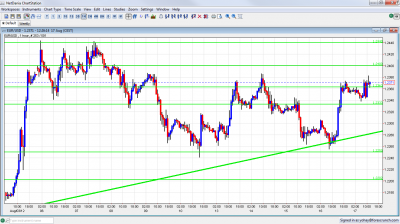EUR/USD is now trading on the high end of the range, after German Chancellor Angela Merkel reiterated her commitment to resolving the crisis, including the use of ECB funds. This counters calls in Germany for curbing the powers of the ECB. The pair is also cheered by the upcoming Spanish bailout request. US indicators point in different directions, depending on which sector you look at.
Here’s an update about technical lines, fundamental indicators and sentiment regarding EUR/USD.
EUR/USD Technical
- Asian session: Euro/dollar remained on high ground after the move yesterday in the US session.
- Current range: 1.2360 – 1.24.
Further levels in both directions:
- Below: 1.2360, 1.2330, 1.2250, 1.22, 1.2144, 1.2043, 1.20, 1.1876 and 1.17.
- Above: 1.24, 1.2440, 1.2520, 1.2623, 1.2670, 1.2743 and 1.2814.
- Note that the pair enjoys uptrend support – it started in mid-July and the pair bounced off this line.
- 1.24 is looming above. Will it be broken in the third try.
- 1.2250 emerges as strong support.
Euro/Dollar on high ground – click on the graph to enlarge.
EUR/USD Fundamentals
- 6:00 German PPI. Exp. +0.4%. Actual: 0%.
- 8:00 Euro-zone Current Account. Exp. 7.8 billion. Actual: 12.7 billion.
- 9:00 Euro-zone trade balance. Exp. 5.4 billion. Actual 10.5 billion.
- 13:55 US UoM Consumer Confidence. Exp. 72.5 points.
- 14:00 US CB Leading Index. Exp. +0.2%.
EUR/USD Sentiment
- Merkel pledges support: The leader of Germany returned from her vacation and reiterated the call to do “everything” to save the euro. She also provided her support for the ECB’s moves, after some German politicians wanted to intervene in the central bank’s actions and / or change the voting rules there, in objection to the planned QE blitz. In the meantime, Germany still enjoyed nice growth in Q2, but business sentiment is falling there.
- Spanish request awaited: Two weeks after Spanish PM Rajoy opened the door to asking for help, Spain is still trying to understand the conditions needed from the country in case of massive ECB help. Markets are begin to price in such a request, with a stronger euro and a lower yields on Spanish bonds, at both ends of the curve.
- Greece gets some breathing room: On Tuesday, Greece raised some 4.063 billion euros in a government auction of three-month bonds. The sale provides crucial funds as the country prepares to make a 3.2 billion euro bond repayment to the ECB on Monday – Greece avoided a default. Greek PM Samaras wants more time (until 2016) to meet targets, and the creditors aren’t so keen on more relief for Greece. Talks with the troika will continue in September. See how to trade the Grexit with EUR/USD.
- Mixed signals in the US: There is a distinct difference between the struggling manufacturing sector (as seen in the NY and Philly indices) and the housing sector, which continues to surprise. Retail sales came out better than expected and jobless claims remain at relatively low levels. Speculation about QE by the Fed refuses to go away. Boston Federal Reserve President Eric Rosengren recently declared that the Fed should implement QE3 in order to help the troubled US economy. The fear of deflation triggered QE2. Deflation isn’t here yet, but the recent slide in inflation gives fuel to the QE3 camp. Fed Chairman Bernanke poured more cold water on QE intervention by the Fed, calling it a program of “diminshing returns”.
- Italian economy sputtering: Borrowing costs rose after Italy auctioned the full targeted amount of EUR8 billion of one-year government bonds at a yield of 1.69%. This was up from the previous auction, which netted a yield of 1.55%. The economic picture in Italy is grim, as the country is carrying a debt-to-GDP ratio of 123%, and with another GDP decline, has officially been in recession for one full year. The Italian PM Mario Monti has been very active of late, but his popularity in Italy is diminishing, and he also managed to anger the Germans by taking a swipe and dismissing the importance of the Bundestag.

